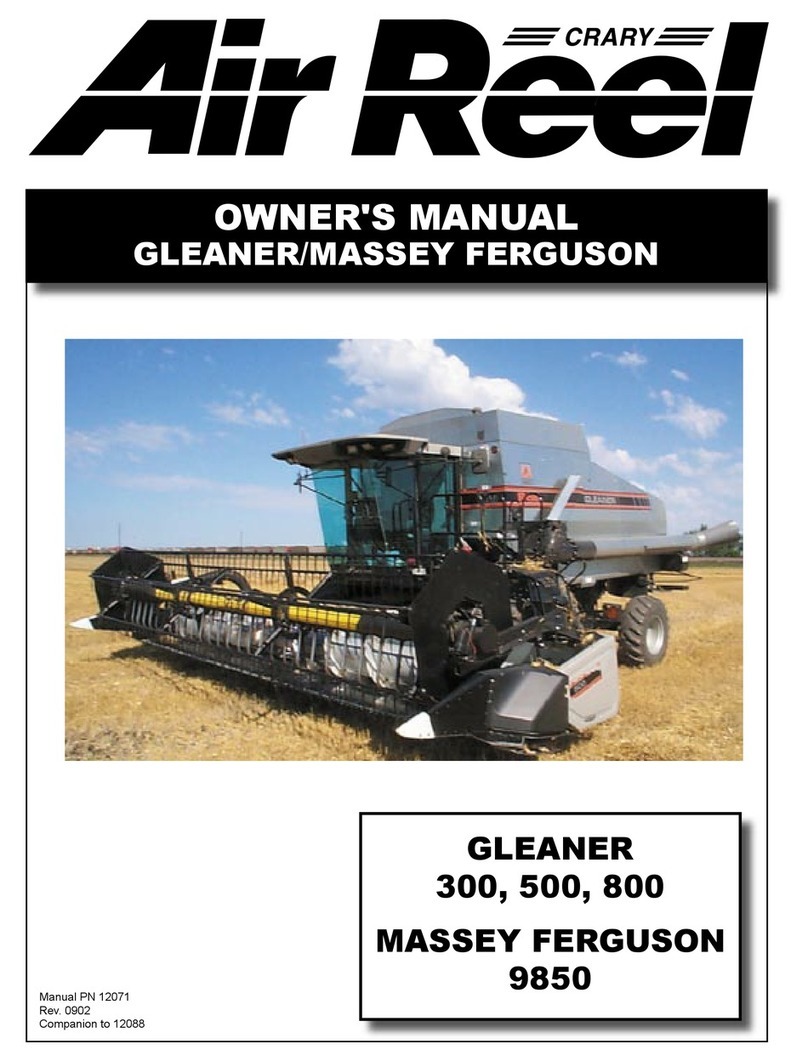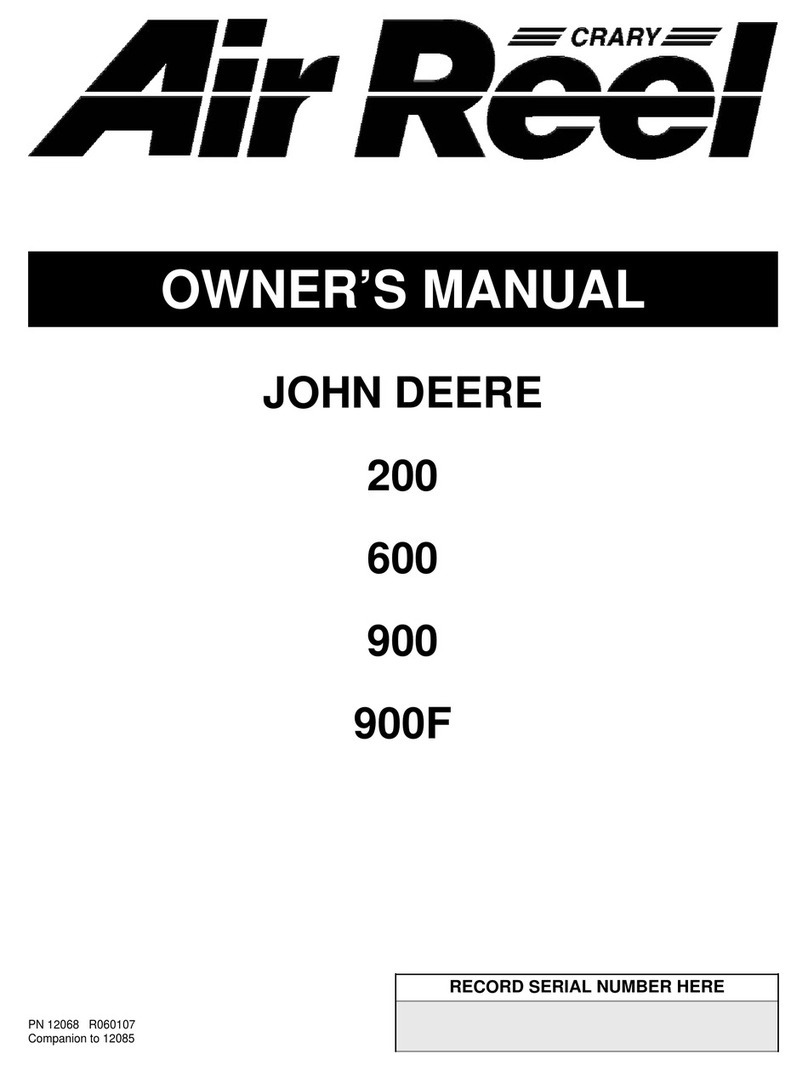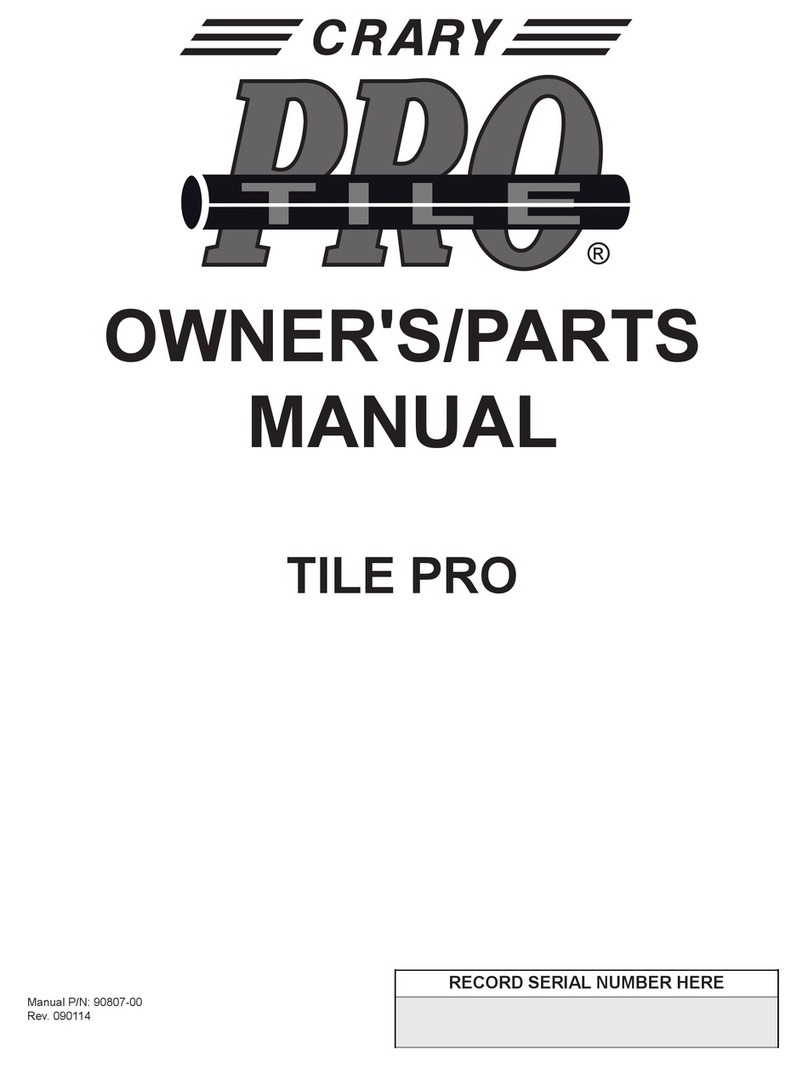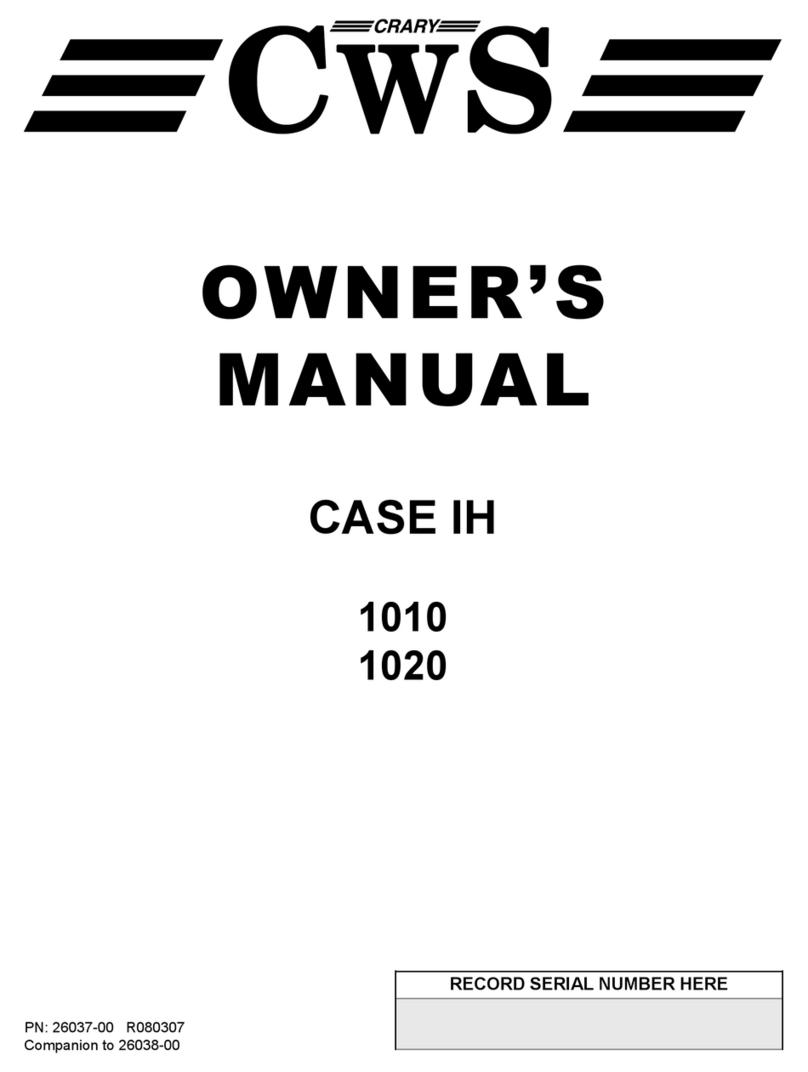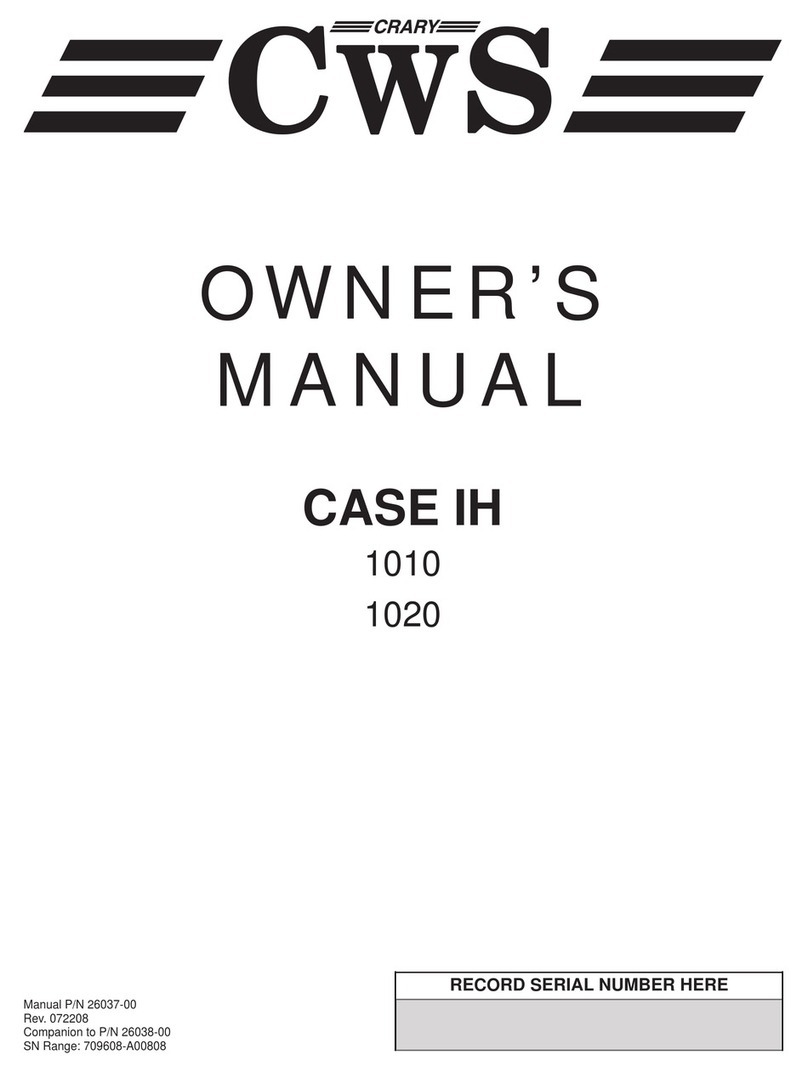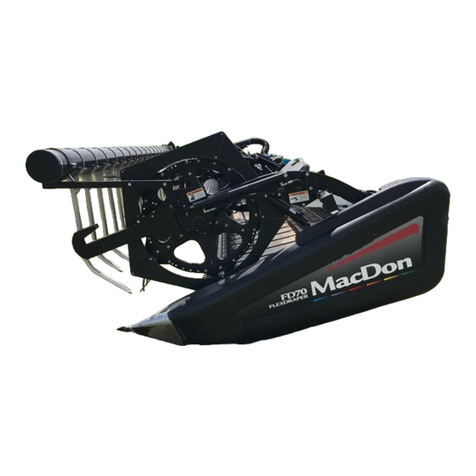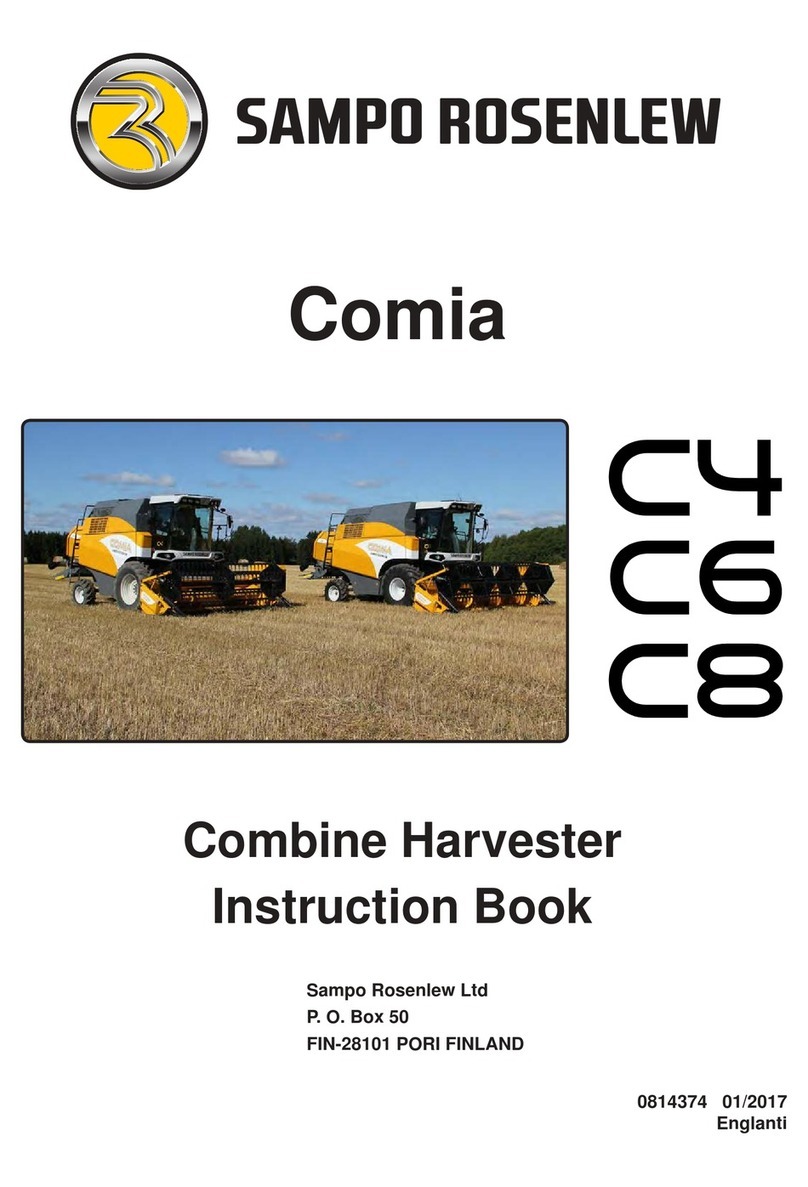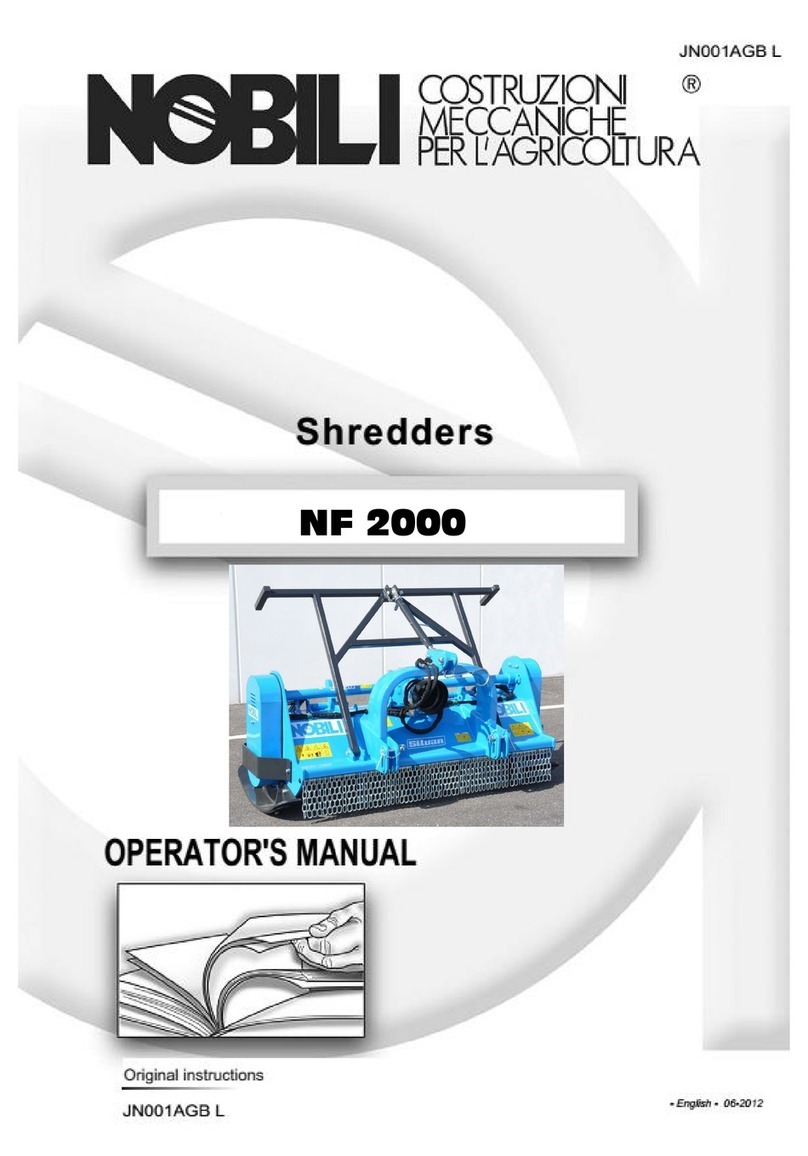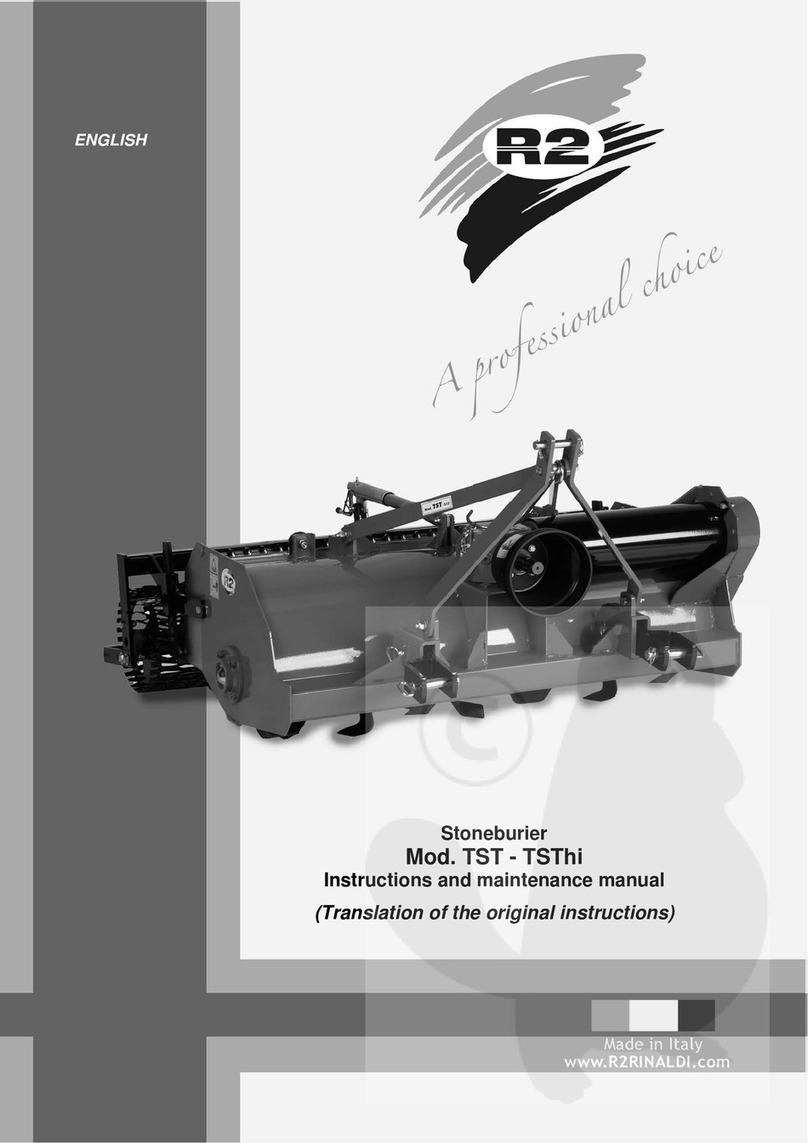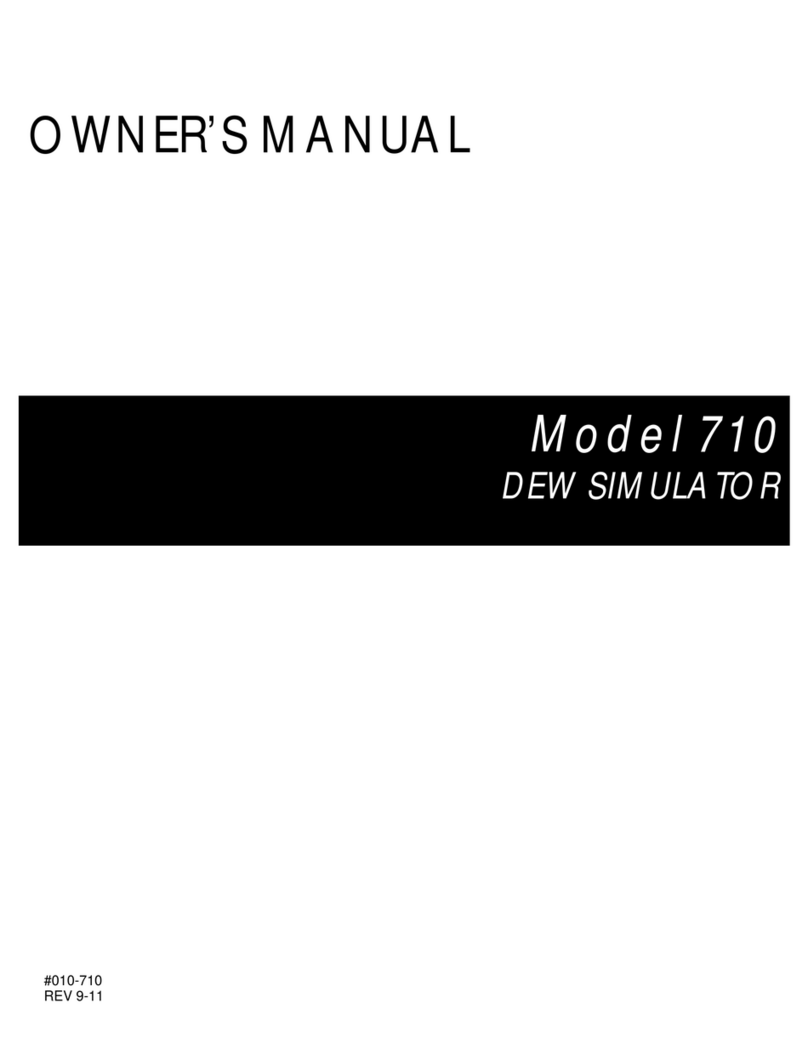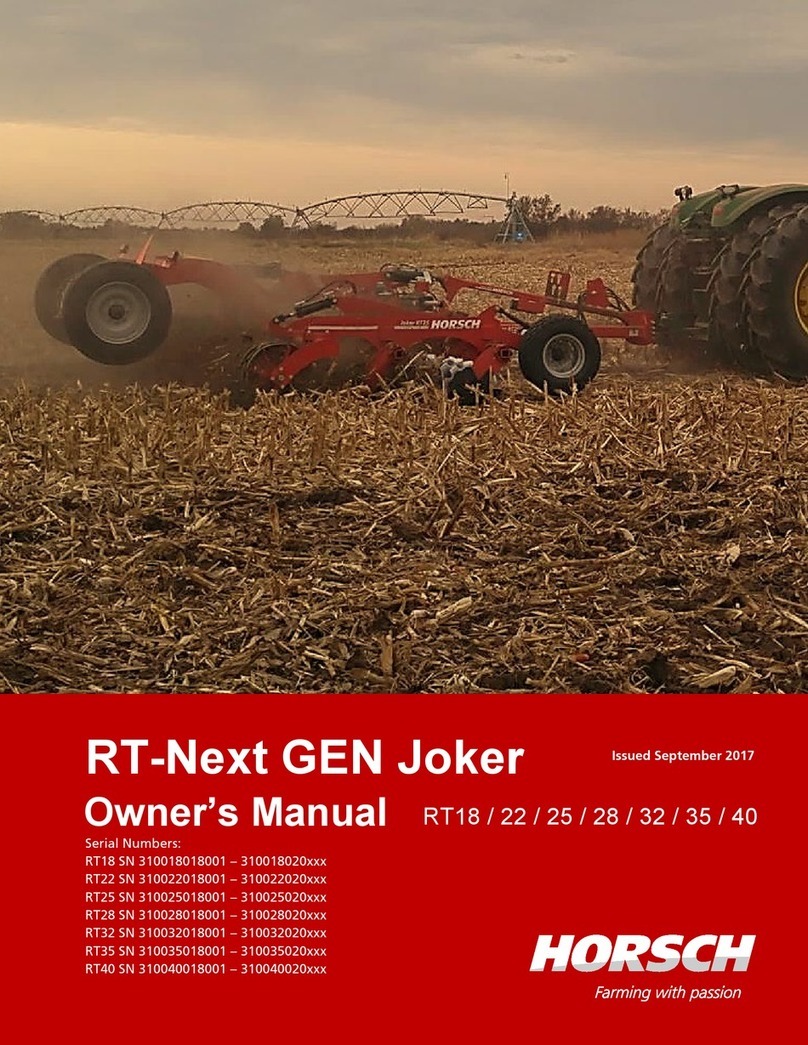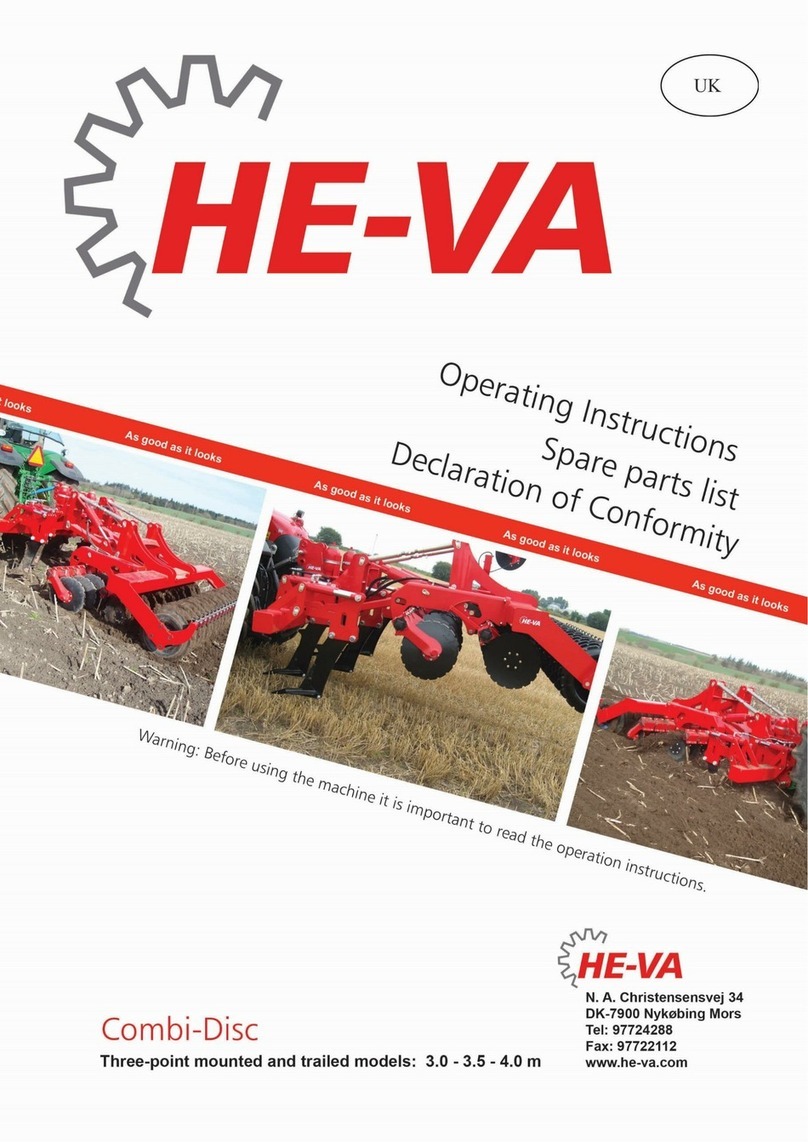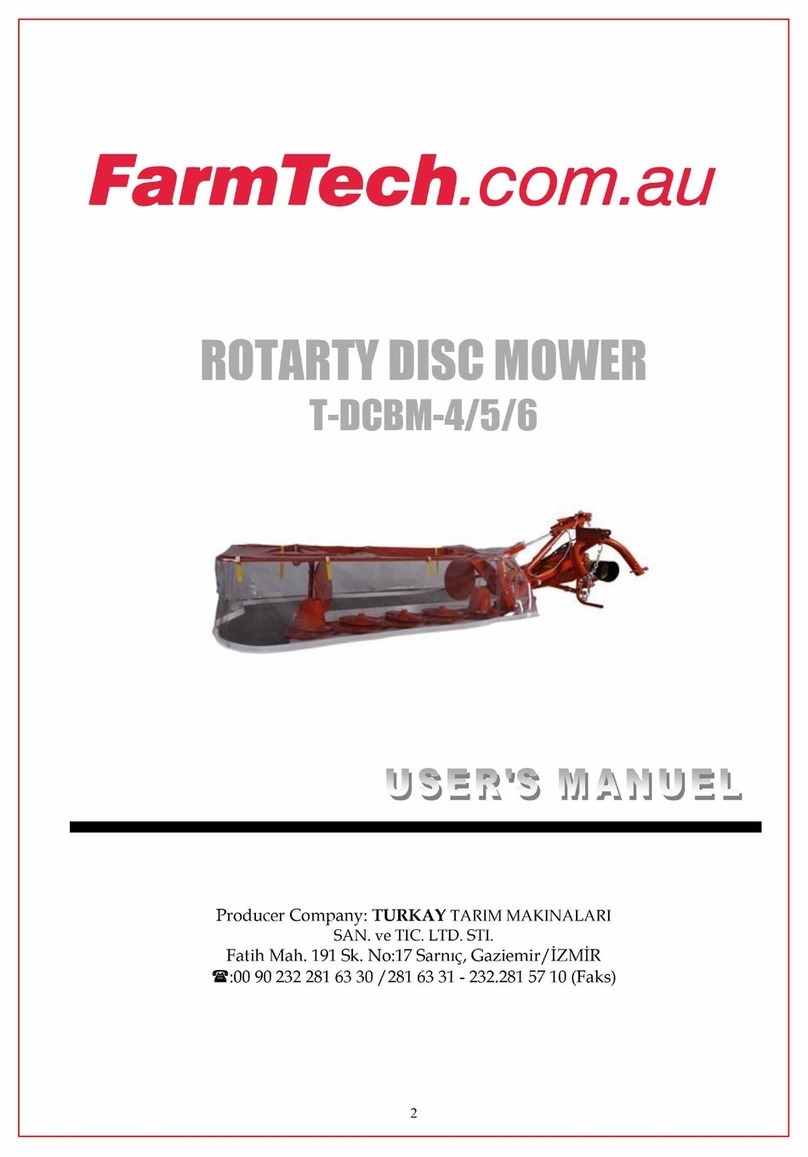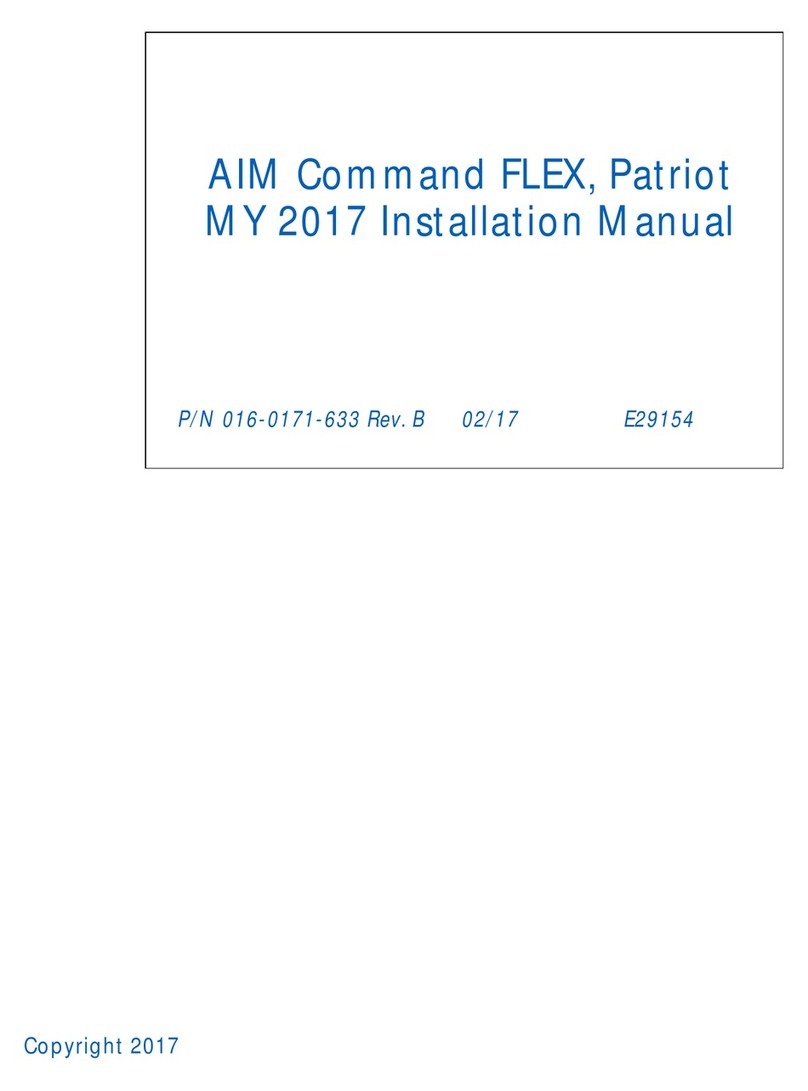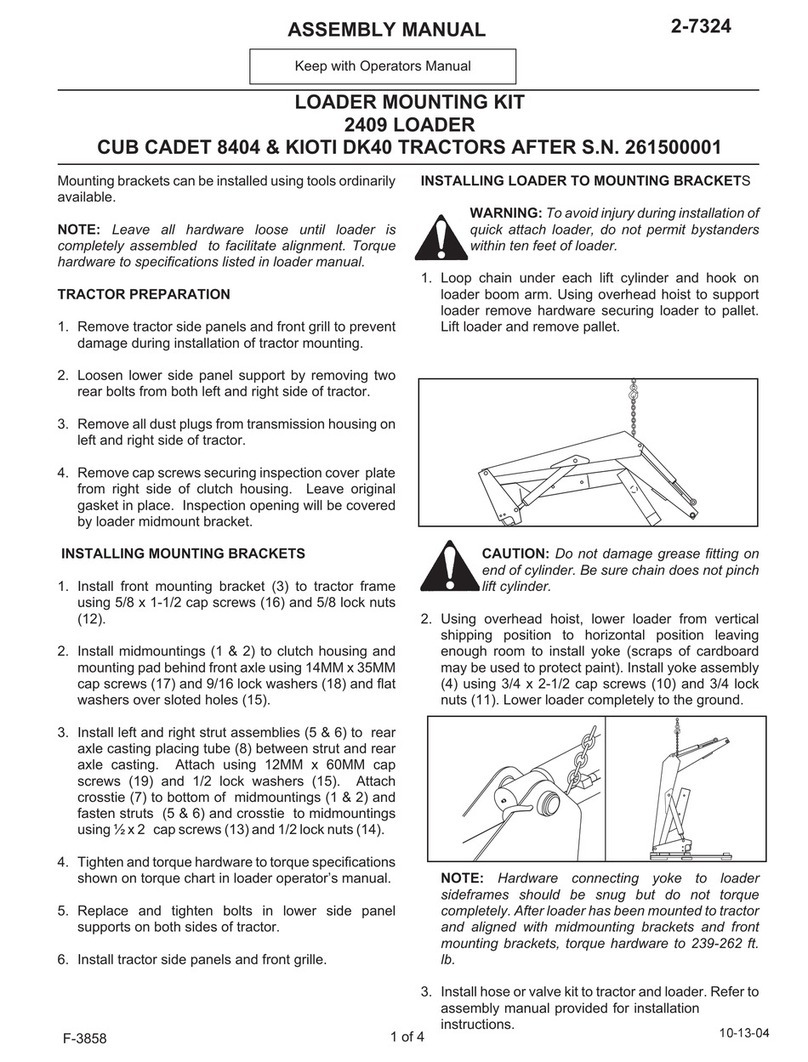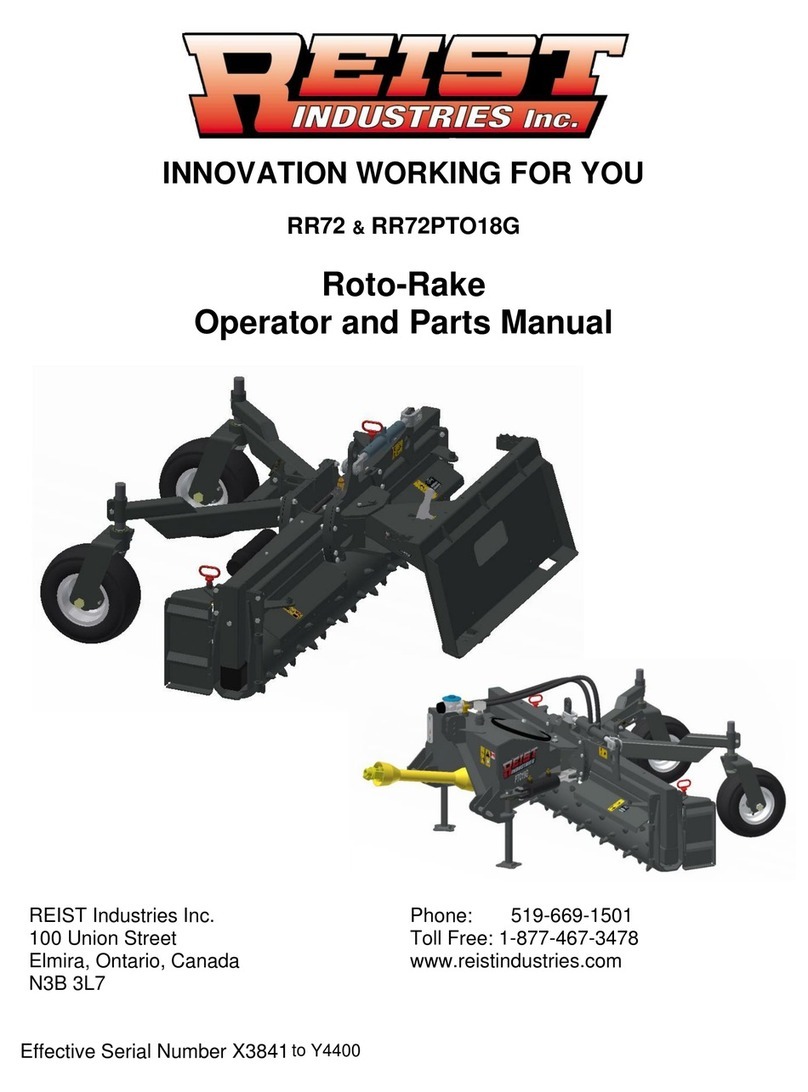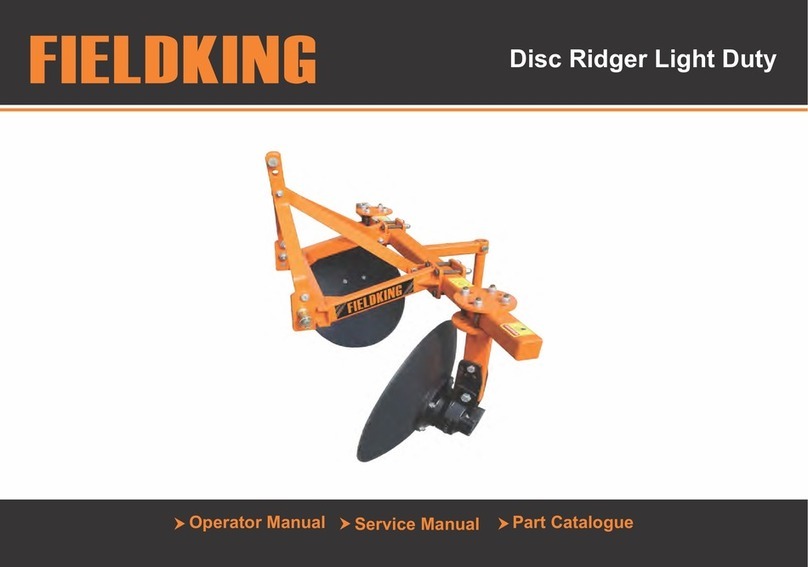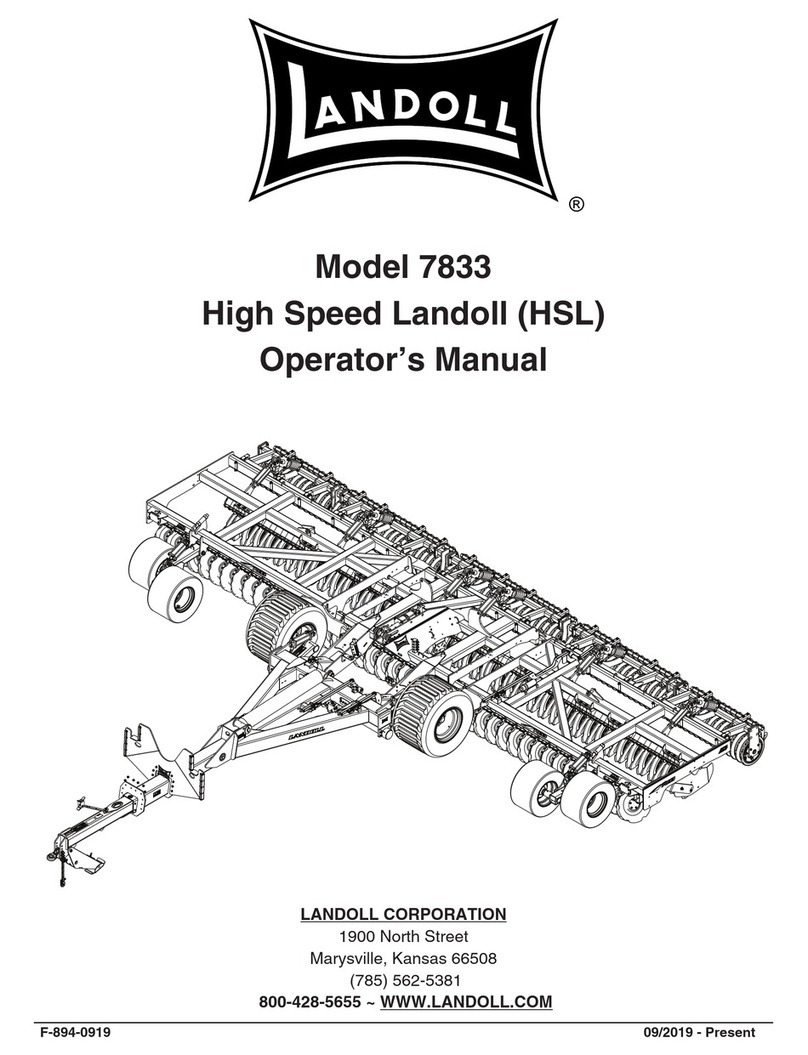Crary Air Reel User manual

RECORD SERIAL NUMBER HERE
Manual P/N 12071
Rev. 122210
Companion to P/N 12088
SN Range: B00034-D00000
OWNER’S MANUAL
AGCO
CHALLENGER FHB SERIES
GLEANER SERIES 2, 3, 5, 7 & 8
GLEANER/MASSEY FERGUSON 8200
MASSEY FERGUSON 9750 & 9850

© 2010, Crary Industries, All rights reserved. Produced and printed in the USA.
HOW TO REACH US
ADDRESS HOURS TELEPHONE
FAX NUMBER E-MAIL
INTERNET
Crary Industries, Inc.
237 12th St. NW
West Fargo, ND 58078
Monday-Friday
8 am-5pm (CST)
For Parts and Service:
Ph: 701.282.5520 •
800.247.7335
Fax: 701.282.9522
Email: service@crary.com •
sales@crary.com
Online: www.crary.com
DISCLAIMER
This document is based on information available at the time of its publication. While efforts have been made to be ac-
curate, the information contained herein does not purport to cover all details or variations, nor to provide for every pos-
sible contingency in connection with installation, operation, or maintenance. Features may be described herein which
are not present in all systems. Crary Industries assumes no obligation of notice to holders of this document with respect
to changes subsequently made.
Crary Industries assumes no responsibility for the accuracy, completeness, sufficiency, or usefulness of the information
contained herein.
SPECIFICATIONS AND DESIGN ARE SUBJECT TO CHANGE WITHOUT NOTICE.
Crary Industries is continually making improvements and developing new equipment. In doing so, we reserve the right
to make changes or add improvements to our product without obligation for equipment previously sold.
Because modification to this machine may affect the performance, function, and safety of its operation, no modifications
are to be made without the written permission of Crary Industries. Part replacements should be with original equipment
supplied by Crary Industries.
THE CRARY INDUSTRIES STATEMENT OF PRODUCT SAFETY
As a manufacturer of specialized agricultural equipment, Crary Industries fully recognizes its responsibility of providing
its customers products that perform their expected use in a reasonably safe manner. Safety considerations shall be an
integral and high priority part of all engineering/design analysis and judgments involving Crary products. It is our stated
policy that our products will be manufactured to comply with the safety standards specified by the American Society of
Agricultural Engineers, the National Electrical Code, the Society of Automotive Engineers, and/or any other applicable
recognized standards at the time manufactured. However, this statement should not be construed to mean that our
product will safeguard against a customer’s own carelessness or neglect in violating common safety practices specified
in each product’s manual, nor will we be liable for any such act.
SERIAL NUMBER LOCATION
Always give your authorized Crary dealer the serial number
of your machine when ordering parts, requesting service, or
any other information. The serial number decal is located on
the front, left hand end of the air manifold.
Please record the serial number in the space provided on
the front cover and on the warranty and registration card.
MANUFACTURED BY CRARY INDUSTRIES
MANUFACTURED IN U.S.A.
XXXXXX
WEST FARGO, NORTH DAKOTA 58078 U.S.A.
SERIAL NUMBER
Serial Number Decal

PN 12071 R122210 iii
LIMITED WARRANTY
This warranty applies to all AG and Outdoor Power Equipment manufactured by Crary Industries.
Crary Industries warrants to the original owner each new Crary Industries product to be free from defects
in material and workmanship, under normal use and service. The warranty shall extend 1 year from date of
delivery for income producing (commercial) applications and 2 years from date of delivery for non-income
producing (consumer) use of the product. The product is warranted to the original owner as evidenced by a
completed warranty registration on file at Crary Industries. Replacement parts are warranted for (90) days
from date of installation.
ALL FINGERAIR REELAND CWS SYSTEMS MANUFACTURED WITHA SERIALNUMBER BEGINNING
WITH THE LETTER “B”AND LATER WILL HAVEALIMITED 2 SEASON WARRANTY ON THE COMPETE
SYSTEM.
The warranty registration must be completed and returned to Crary Industries within 10 days of delivery of
the product to the original owner or the warranty will be void.
In the event of a failure, return the product, at your cost, along with proof of purchase to the selling Crary In-
dustries dealer. Crary Industries will, at its option, repair or replace any parts found to be defective in material
or workmanship. Warranty on any repairs will not extend beyond the product warranty. Repair or attempted
repair by anyone other than a Crary Industries dealer as well as subsequent failure or damage that may occur
as a result of that work will not be paid under this warranty. Crary Industries does not warrant replacement
components not manufactured or sold by Crary Industries.
1. This warranty applies only to parts or components that are defective in material or workmanship.
2. This warranty does not cover normal wear items including but not limited to bearings, belts, pulleys, filters
and chipper knives.
3. This warranty does not cover normal maintenance, service or adjustments.
4. This warranty does not cover depreciation or damage due to misuse, negligence, accident or improper
maintenance.
5. This warranty does not cover damage due to improper setup, installation or adjustment.
6. This warranty does not cover damage due to unauthorized modifications of the product.
7. Engines are warranted by the respective engine manufacturer and are not covered by this warranty.
Crary Industries is not liable for any property damage, personal injury or death resulting from the unauthor-
ized modification or alteration of a Crary product or from the owner’s failure to assemble, install, maintain or
operate the product in accordance with the provisions of the Owner’s manual.
Crary Industries is not liable for indirect, incidental or consequential damages or injuries including but not
limited to loss of crops, loss of profits, rental of substitute equipment or other commercial loss.
This warranty gives you specific legal rights. You may have other rights that may vary from area to area.
Crary Industries makes no warranties, representations or promises, expressed or implied as to the perfor-
mance of its products other than those set forth in this warranty. Neither the dealer nor any other person has
any authority to make any representations, warranties or promises on behalf of Crary Industries or to modify
the terms or limitations of this warranty in any way. Crary Industries, at its discretion, may periodically offer
limited, written enhancements to this warranty.
CRARY INDUSTRIES RESERVES THE RIGHT TO CHANGE THE DESIGNAND/OR SPECIFICATIONS OF
ITSPRODUCTSATANYTIME WITHOUT OBLIGATION TOPREVIOUS PURCHASERS OF ITS PRODUCTS.
NOTE
The warranty will not cover gearboxes that have been disas-
sembled within the warranty period.

PN 12071 R122210iv
GEARBOX FAN KIT
KIT NUMBER NUMBER OF
BOXES IN KIT
22757 1
REEL ARM MOUNT KIT
KIT NUMBER NUMBER OF
BOXES IN KIT
53462 1
53463 1
53464 1
53465 1
53466 1
53467 1
53470 1
53471 1
53472 1
53473 1
53593 1
53594 1
53595 2
53596 2
INSPECTION AFTER DELIVERY
After receiving the shipment of your Air Reel, please ensure that no boxes are missing. The following tables show the
number of boxes included in all kits available for a AGCO Air Reel. Refer to your packing slip to see which kits you should
have received. Then, ensure that all boxes were shipped. Contact your dealer immediately if any boxes are missing.
SEAL KIT
KIT NUMBER NUMBER OF
BOXES IN KIT
12050 1
16516 1
GEARBOX MOUNT DRIVE KIT
KIT NUMBER NUMBER OF
BOXES IN KIT
22676 1
DRIVELINE KIT
KIT NUMBER NUMBER OF
BOXES IN KIT
27699-00 1
27701-00 1
29770-00 1
RIGHT HAND DRIVE KIT
KIT NUMBER NUMBER OF
BOXES IN KIT
24060 1
24061 1
24062 3
24106 3
29773 3
29984 2

PN 12071 R122210 1
TABLE OF CONTENTS
DESCRIPTION PAGE DESCRIPTION PAGE
INTRODUCTION....................................................2
SAFETY .................................................................3
2.1 SAFETY ALERT SYMBOL ................................................................... 3
2.2 GENERAL SAFETY.............................................................................. 4
2.3 OPERATING SAFETY.......................................................................... 5
2.4 MAINTENANCE SAFETY .................................................................... 5
2.5 HYDRAULIC SAFETY.......................................................................... 6
2.6 PTO SAFETY ....................................................................................... 6
2.7 TRANSPORT SAFETY......................................................................... 7
2.8 STORAGE SAFETY ............................................................................. 7
2.9 ASSEMBLY SAFETY............................................................................ 7
2.10 SAFETY DECALS .............................................................................. 7
2.11 SIGN-OFF FORM ............................................................................... 8
SAFETY DECALS..................................................9
ASSEMBLY..........................................................11
4.1 UNCRATING .......................................................................................11
4.2 DRIVELINE ADJUSTMENT................................................................ 12
4.2.1 SHORTENING THE DRIVELINE (OPTION A) ........................ 12
4.2.2 SHORTENING THE DRIVELINE (OPTION B) ........................ 12
4.3 GEARBOX/FAN MOUNT.................................................................... 13
4.4 RIGHT HAND DRIVE KIT (18-24 FT. HEADERS).............................. 14
4.5 RIGHT HAND DRIVE KIT (25-35 FT. HEADERS).............................. 16
4.6 ECCENTRIC MOUNT INSTALLATION .............................................. 18
4.7 IDLER GEAR INSTALLATION (REAR) .............................................. 18
4.8 REEL BAT ARM INSTALLATION........................................................ 19
4.9 IDLER GEAR INSTALLATION (FRONT) ............................................. 19
4.10 AIR TUBES....................................................................................... 20
4.11 REEL BATS ...................................................................................... 21
4.12 HYDRAULIC MOTOR ...................................................................... 22
4.13 ECCENTRIC ARM............................................................................ 23
4.14 REEL SUPPORT INSTALLATION (ALL HEADERS
EXCEPT MF 9750)........................................................................... 24
4.14.1 MANUAL FORE/AFT HEADERS........................................... 24
4.14.2 ELECTRIC FORE/AFT HEADERS ........................................ 25
4.15 REEL SUPPORT INSTALLATION (MASSEY FERGUSON 9750) ... 26
4.15.1 MANUAL FORE/AFT HEADERS........................................... 26
4.15.2 ELECTRIC/HYDRAULIC FORE/AFT..................................... 26
4.16 REEL TO HEADER INSTALLATION ................................................ 27
4.17 MANIFOLD TILT............................................................................... 27
4.18 AIR HOSE......................................................................................... 28
4.19 ELECTRICAL WIRING ..................................................................... 30
4.20 OPTIONAL EQUIPMENT ................................................................. 31
4.20.1 AUXILIARY REEL TINE KIT .................................................. 31
4.20.2 GEARBOX/FAN EXTENSION ............................................... 32
OPERATION ........................................................34
5.1 MACHINE COMPONENTS ................................................................ 35
5.2 INITIAL ADJUSTMENTS .................................................................... 36
5.2.1 REEL ADJUSTMENT............................................................... 36
5.2.2 TINE PITCH ADJUSTMENT .................................................... 37
5.2.3 TORQUE LIMITER (SLIP CLUTCH) RUN-IN .......................... 38
5.3 PRE-OPERATION CHECKLIST......................................................... 38
5.4 MACHINE BREAK-IN ......................................................................... 38
5.4.1 PRE-START INSPECTION...................................................... 38
5.4.2 AFTER OPERATING FOR 2 HOURS...................................... 39
5.4.3 AFTER OPERATING FOR 10 HOURS:................................... 39
5.5 CONTROLS........................................................................................ 39
5.6 OPERATING HINTS........................................................................... 40
5.7 TRANSPORTING ............................................................................... 40
5.8 STORAGE .......................................................................................... 41
SERVICE & MAINTENANCE...............................42
6.1 MAINTENANCE CHECKLIST ............................................................ 42
6.2 FLUIDS AND LUBRICANTS............................................................... 43
6.3 GREASING......................................................................................... 43
6.4 GEARBOX OIL ................................................................................... 43
6.5 PTO LUBRICATION ........................................................................... 44
6.6 IDLER GEAR TENSION..................................................................... 44
6.7 ECCENTRIC ROLLERS (PLASTIC) .................................................. 45
6.8 FAN HOUSING AND AIR HOSE ........................................................ 46
6.9 FRICTION DISC TORQUE LIMITER ................................................. 46
TROUBLESHOOTING.........................................47
SPECIFICATIONS................................................48
8.1 REEL SPECIFICATIONS.................................................................... 48
8.2 FAN PERFORMANCE DATA.............................................................. 48
8.3 HYDRAULIC MOTOR DATA............................................................... 49
8.4 HYDRAULIC FITTING TORQUE ....................................................... 50
8.5 BOLT TORQUE .................................................................................. 51

PN 12071 R1222102
Section INTRODUCTION
1
Congratulations on your choice of a new Air Reel to complement your farming operation. This equipment has been
designed and manufactured to meet the needs of a discerning agricultural industry for the efficient harvesting of crops.
Safe, efficient, and trouble free operation of your Air Reel requires that you and anyone else who will be operating or
maintaining the machine, read and understand the Safety, Operation, Maintenance, and Troubleshooting information
contained within the Operator’s Manual. Check each item referred to and acquaint yourself with the adjustments required
to obtain efficient operation.
This manual covers all models of the Air Reel manufactured by Crary Industries for AGCO headers. Use the table of
contents as a guide to locate required information.
Keep this manual handy for frequent reference and to pass on to new operators or owners. Call your Crary dealer or
distributor if you need assistance, information, or additional copies of the manuals.
Many people have worked on the design, production, and delivery of this machine. They have built into it the highest
quality of materials and workmanship. The information in this manual is based on the knowledge, study, and experience
of these people through years of manufacturing specialized farming machinery.
The performance of the machine depends on proper maintenance and adjustment. Even if you are an experienced
operator of this or similar equipment, we ask you to read the operator’s manual before running the machine. Keep the
manual handy for future reference. It has been carefully prepared, organized, and illustrated to assist you in finding the
information you need. Your Crary dealer will be happy to answer any further questions you may have about the machine.
OPERATOR ORIENTATION - All references to left, right, front and rear of the machine, as mentioned throughout the
manual, are determined by standing behind the machine and facing towards the direction of forward travel.

PN 12071 R122210 3
SAFETY
Section
2
2.1 SAFETY ALERT SYMBOL
This Safety Alert Symbol means:
ATTENTION! BECOME ALERT!
YOUR SAFETY IS INVOLVED!
The Safety Alert symbol identifies important
safety messages on the Air Reel and in the
manual. When you see this symbol, be
alert to the possibility of personal injury or
death. Follow the instructions in the safety
message.
DANGER - Indicates an imminently hazardous situation
that, if not avoided, will result in death or serious injury.
This signal word is to be limited to the most extreme
situations, typically for machine components that, for
functional purposes, cannot be guarded.
WARNING - Indicates a potentially hazardous situation
that, if not avoided, could result in death or serious
injury, and includes hazards that are exposed when
guards are removed. It may also be used to alert
against unsafe practices.
CAUTION - Indicates a potentially hazardous situation
that, if not avoided, may result in minor or moderate
injury. It may also be used to alert against unsafe
practices.
IMPORTANT - Instructions that must be followed to
ensure proper installation/operation of equipment.
NOTE - General statements to assist the reader.
Why is SAFETY important to you?
1. Accidents Disable and Kill
2. Accidents Cost
3. Accidents Can Be Avoided
SIGNAL WORDS:
Note the use of the signal words DANGER, WARNING,
CAUTION, IMPORTANT and NOTE with the safety
messages. The appropriate signal word for each mes-
sage has been selected using the following guidelines:
3 Big Reasons

PN 12071 R1222104
SAFETY
YOU are responsible for the SAFE operation and main-
tenance of your machine. You must ensure that you and
anyone else who is going to operate, maintain or work
around the machine are familiar with the operating and
maintenance procedures and related safety information
contained in this manual. This manual will alert you to
all good safety practices that should be adhered to while
operating the machine.
Remember, YOU are the key to safety. Good safety prac-
tices not only protect you but also the people around you.
Make these practices a working part of your safety program.
Be certain that EVERYONE operating this equipment is
familiar with the recommended operating and maintenance
procedures and follows all the safety precautions. Most
accidents can be prevented. Do not risk injury or death by
ignoring good safety practices.
• Owners must give operating instructions to opera-
tors or employees before allowing them to operate
the machine, and annually thereafter per OSHA
(Occupational Safety and Health Administration)
regulation 1928.57.
• The most important safety device on this equipment
is a safe operator. It is the operator’s responsibility
to read and understand all Safety and Operating
instructions in the manual and to follow them. All
accidents can be avoided.
• A person who has not read and understood all
operating and safety instructions is not qualified
to operate the machine. An untrained operator
exposes himself and bystanders to possible seri-
ous injury or death.
• Do not modify the equipment in anyway. Unauthor-
ized modification may impair the function and/or
safety and could affect the life of the equipment.
1. Read and understand the
Owner’s Manual and all safe-
ty decals before operating,
maintaining, adjusting or
servicing the machine.
2. Only trained persons shall
operate the machine. An
untrained operator is not
qualified to operate the machine.
3. Have a first-aid kit available for use,
should the need arise, and know how
to use it.
4. Provide a fire extinguisher for use in case of an accident.
Store in a highly visible place.
5. Do not allow children, spectators or by-
standers within hazard area of machine.
6. Wear appropriate protective gear. This
list includes but is not limited to:
• A hard hat.
• Protective shoes with slip
resistant soles.
• Protective goggles.
• Heavy gloves.
• Hearing protection.
• Respirator or filter mask.
7. Wear suitable ear protection during prolonged exposure
to excessive noise.
8. Place all controls in neutral or off, lower header to the
ground, stop combine engine, set parking brake, chock
wheels, remove ignition key and wait
for all moving parts to stop, before
servicing, adjusting, repairing or
unplugging.
9. Review safety related items annually
with all personnel who will be operat-
ing or maintaining the machine.
Think SAFETY! Work SAFELY!
2.2 GENERAL SAFETY

PN 12071 R122210 5
SAFETY
1. Follow ALL operating, maintenance, and safety informa-
tion in this manual.
2. Support the machine with blocks or safety stands when
working around it.
3. Follow good shop practices:
• Keep service area clean
and dry.
• Be sure electrical outlets
and tools are properly
grounded.
• Use adequate light for the
job at hand.
4. Use only tools, jacks and hoists of sufficient capacity
for the job.
5. Place all controls in neutral or off, lower header to the
ground, stop combine engine, set parking brake, chock
wheels, remove ignition key and wait for all moving
parts to stop before servicing, adjusting, repairing or
unplugging.
6. When maintenance work is completed, install and se-
cure all guards before resuming work.
7. Relieve pressure from hydraulic circuit before servicing
or disconnecting from combine.
8. Keep hands, feet, hair and clothing away from all mov-
ing and/or rotating parts.
9. Clear the area of bystanders, especially small children,
when carrying out any maintenance and repairs or mak-
ing any adjustments.
10. Keep safety decals clean. Replace any decal that is
damaged or not clearly visible.
11. First-class maintenance is a prerequisite for the safest
operation of your machine. Maintenance, including
lubrications, should be performed with the machine
stopped and locked out.
1. Read and understand the Owner’s Manual and all safety
decals before servicing, adjusting or repairing.
2. Install and secure all guards and shields before starting
or operating.
3. Keep hands, feet, hair and clothing away from all mov-
ing and/or rotating parts.
4. Place all controls in neutral or off, lower header to the
ground, stop combine engine, set parking brake, chock
wheels, remove ignition key and wait for all moving
parts to stop before servicing, adjusting, repairing or
unplugging.
5. Clear the area of bystanders, especially small children,
before starting.
6. Keep all hydraulic lines, fittings, and couplers tight and
free of leaks before and during use.
7. Clean reflectors and lights before transporting.
8. Review safety related items annually with all personnel
who will be operating or maintaining the machine.
9. Shut the combine off when connecting the machine
hydraulics.
10. Do not exceed fan speed of 5300 RPM. Check the fan
speed by multiplying the drive shaft speed (RPM) by
the gear ratio of the gearbox.
11. Do not run the fan without back pressure. Close the
butterfly valve on the fan if the flex hose is disconnected.
2.3 OPERATING SAFETY 2.4 MAINTENANCE SAFETY
Think SAFETY! Work SAFELY!

PN 12071 R1222106
SAFETY
1. Always place all combine hydraulic controls in neutral
before disconnecting from combine or working on hy-
draulic system.
2. Make sure that all components in the hydraulic system
are kept in good condition and are clean.
3. Relieve pressure before working on the hydraulic
system.
4. Replace any worn, cut, abraded, flattened or crimped
hoses.
5. Do not attempt any makeshift repairs to the hydraulic
fittings or hoses by using tape, clamps or cements.
The hydraulic system operates under extremely high-
pressure. Such repairs will fail suddenly and create a
hazardous and unsafe condition.
6. Wear proper hand and eye protec-
tion when searching for a high-
pressure hydraulic leak. Use a
piece of wood or cardboard as
a backstop instead of hands to
isolate and identify a leak.
7. If injured by a concentrated high-
pressure stream of hydraulic fluid,
seek medical attention immedi-
ately. Serious infection or toxic
reaction can develop from hydrau-
lic fluid piercing the skin surface.
8. Before applying pressure to the system, make sure all
components are tight and that lines, hoses, and cou-
plings are not damaged.
1. Keep bystanders, especially children, away from drive
shafts.
2. Be extremely careful when working around PTO shafts,
drivelines, or other rotating shafts.
3. Do not remove or modify protective shields or guards.
4. Do not step across a PTO shaft or driveline or use it
as a step.
5. Keep guards and shields in place at all times while
operating.
6. Replace all damaged or missing parts or shields with
the correct original manufacturer’s parts.
7. Grease, clean, and maintain PTO components ac-
cording to original manufacturer’s specifications and
information in this manual.
8. Clothing worn by the operator must be fairly tight.
Never wear loose-fitted jackets, shirts, or pants when
working around the drive shafts. Tie long hair back or
put under a cap.
9. Keep hydraulic hoses, electrical cords, chains, and
other items from contacting the drive shafts.
10. Do not clean, lubricate, or adjust the drive shafts when
the reel is engaged and the combine is running.`
2.5 HYDRAULIC SAFETY 2.6 PTO SAFETY
Think SAFETY! Work SAFELY!

PN 12071 R122210 7
SAFETY
1. Make sure you are in compliance with all local regula-
tions regarding transporting equipment on public roads
and highways.
2. It is the responsibility of the owner to know the lighting
and marking requirements of the local highway authori-
ties and to install and maintain the equipment to provide
compliance with the regulations. Add extra lights when
transporting at night or during periods of limited visibility.
3. See the Owner’s manual that came with your combine
and header for proper transportation.
1. Keep safety decals clean and legible at all times.
2. Replace safety decals that are missing or have become
illegible.
3. Replaced parts that displayed a safety decal should
also display the current decal.
4. Decals that need to be replaced, are to be placed back
in the original location.
5. Safety decals are available from your authorized dealer
or the factory.
HOW TO INSTALL SAFETY DECALS:
1. Be sure that the installation area is clean and dry.
2. Be sure temperature is above 50°F (10°C).
3. Decide on the exact position before you remove the
backing paper.
4. Remove the smaller portion of the split backing paper.
5. Align the decal over the specified area and carefully
press the small portion with the exposed sticky back-
ing in place.
6. Slowly peel back the remaining paper and carefully
smooth the remaining portion of the decal in place.
7. Small air pockets can be pierced with a pin and
smoothed out using the piece of decal backing paper.
Think SAFETY! Work SAFELY!
2.7 TRANSPORT SAFETY 2.10 SAFETY DECALS
2.8 STORAGE SAFETY
2.9 ASSEMBLY SAFETY
1. Store the unit in an area away from human activity.
2. Do not permit children to play on or around the stored
machine.
3. See the Owner’s manual that came with your combine
and header for proper storage.
1. Assemble in an area with sufficient space to handle
the largest component and access to all sides of the
machine
2. Use only lifts, cranes and tools with sufficient capacity
for the load.
3. When necessary, have someone assist you.
4. Do not allow spectators in the working area.

PN 12071 R1222108
SAFETY
Crary Industries follows the general Safety Standards specified by the American Society of Agricultural Engineers (ASAE)
and the Occupational Safety and Health Administration (OSHA). Anyone who will be operating and/or maintaining the
equipment must read and clearly understand ALL Safety, Operating and Maintenance information presented in this manual.
Do not operate or allow anyone else to operate this equipment until such information has been reviewed. Annually review
this information before the season start-up.
Make these periodic reviews of SAFETY and OPERATION a standard practice for all of your equipment. An untrained
operator is unqualified to operate this machine.
A sign-off sheet is provided for your record keeping to show that all personnel who will be working with the equipment have
read and understand the information in the owner’s manual and have been instructed in the operation of the equipment.
SIGN - OFF FORM
DATE EMPLOYEE SIGNATURE EMPLOYER SIGNATURE
2.11 SIGN-OFF FORM

PN 12071 R122210 9
Good safety requires that you familiarize yourself with the various safety decals, the type of warning and the area, or
particular function related to that area, that requires your SAFETY AWARENESS.
Think SAFETY! Work SAFELY!
REMEMBER - If safety decals have been damaged, removed or become illegible or parts have been replaced without safety decals,
new decals must be applied. New safety decals are available from the manufacturer or an authorized dealer.
SAFETY DECALS
Section
3
Decal location
B
PN 11002 - Decal, Warning
A
PN 11001 - Decal, Caution

PN 12071 R12221010

PN 12071 R122210 11
Section ASSEMBLY
4
4.1 UNCRATING
1. Locate the manifold and bats crate.
2. Cut the metal bands and remove the 2” X 4”s and saddle
tops (Figure 1).
Figure 1: Manifold and bats crate
Figure 2: Manifold and bats crate
Figure 3: Manifold and bats crate
Read all instructions to become familiar with the parts and procedure used before starting the actual work. You may
refer to the parts catalog for additional aid in assembling the Air Reel.
1. Assemble in an area with sufficient space to handle
the largest component and access to all sides of
the machine
2. Use only lifts, cranes and tools with sufficient capac-
ity for the load.
3. When necessary, have someone assist you.
4. Do not allow spectators in the working area.
WARNING
1. The sawhorses must be capable of supporting 600
pounds each.
2. The sawhorses must be at least 3 feet high.
3. The sawhorses must be blocked, to keep the mani-
fold from rolling.
WARNING
3. Remove the bat assemblies from the crate and place
to the side.
4. Remove the lag screws from the mounting clamps (as
shown in Figure 2) from all locations.
5. Using an overhead hoist and a nylon strap, sling or
chain, connect to the center of the manifold (Figure 3).
6. Remove from crate, and set down on two steel saw-
horses (or equivalent) two to four inches from the ends
of the manifold.
A. The sawhorses must be capable of supporting
600 pounds each.
B. The sawhorses must be at least 3 feet high.

PN 12071 R12221012
ASSEMBLY
4.2.1 SHORTENING THE DRIVELINE (OPTION A)
1. Pull the driveline into two pieces. Connect one end to
the combine and the other end to the drive shaft. Line
up the two halves parallel to each other.
2. Measure the distance from the end of one driveline tube
to the bottom of the end shield of the other driveline
half (dimension A in Figure 4). Measure and mark the
driveline tube 1-9/16” inward from dimension A.
3. Cut the shield tube in the marked position.
4. Using the cut piece of shield tube as your measurement,
place the cut piece against the end of the shaft. Mark
and cut the shaft.
5. Using the cut piece of shield tube as your measurement,
mark and cut the tube on the other half of the driveline,
and then the shaft.
6. File both shaft ends, and slide the two halves back
together.
4.2 DRIVELINE ADJUSTMENT
Figure 4: Shorten the driveline if it is too long
4.2.2 SHORTENING THE DRIVELINE (OPTION B)
1. Using a Phillips screwdriver, remove the screw at the
flexible cone base of the outer shield tube. Then, twist
the flexible cone until the cone flare aligns with the
bearing tab (See Figure 5). Pull the yoke and inner
profile out of the tubing.
2. Remove the spring pin.
3. Find a pipe that is large enough to slide the inner profile
inside, but is small enough that the end yoke will not
pass through. This pipe should extend at least 4 inches
past the end of the driveline inner profile.
A. Insert the inner profile into the pipe.
B. Place a steel plate on the floor and, with the
yoke pointing up, bounce the pipe on the steel
plate. After several bounces, the inner profile
should drop out of the yoke and onto the floor.
4. Cut the yoke end of both the shaft and shield tube by
the length determined.
5. Insert the profile back into the yoke and drill a new
spring pin hole.
6. Insert the spring pin.
7. Drill new holes in the shield to accept the shield bearing.
8. Install the driveline shield by reversing the disassembly
process from Step 1.
If you determined that your driveline needs to be shortened,
use the following steps to modify the shaft length.
If the amount required to be cut off does not include a grease
zerk use the steps in section 4.3.1. If a grease zerk is within
the cutting area, use the steps in section 4.3.2.
IMPORTANT
The driveline shields must be reinstalled to the original
equipment standards of construction and installation.
Figure 5: Removing the shield tube

PN 12071 R122210 13
NOTE
Applyamediumstrength thread locking agent tothe bolts
used to secure the gearbox mount to the header and the
gearbox to the mount.
ASSEMBLY
GEARBOX
MOUNT
PLATE
1/2” x 1-1/4” SERRATED
FLANGE BOLT
MOUNT PLATE
SUPPORT
1/2” x 1-1/4” SERRATED
FLANGE BOLT
4.3 GEARBOX/FAN MOUNT
Placeall controls inneutral or off, stop combineengine,
set parking brake, remove ignition key, wait for all mov-
ing parts to stop, then properly block machine before
servicing, adjusting, repairing, or unplugging.
WARNING
Figure 6: Mount plate support
1. Position the mount plate support on the rear right hand
side of the header as shown in Figure 6. Refer to Table
1 for Dimension “A.”
2. Using the mount plate support as a template, drill four
27/64” holes through the top and bottom mount plate
support holes and into the rear header panel. Tap the
holes for 1/2” bolts.
3. Install the mount plate support to the header with four
1/2” x 1-1/4” serrated flange bolts (Figure 7). Torque
bolts to 75 ft-lbs.
4. Attach the gearbox mount plates to the mount plate
supportwith four1/2”x 1-1/4” serratedflange bolts and
locknuts. Do not tighten yet.
5. Use a jack or hoist to position the gearbox inside the
gearboxmount plates. Usingfour 1/2” x1-1/4”serrated
flangebolts andwashers,attach the gearboxto the top
set of mount plate holes. Do not tighten yet.
6. Check the gearbox and, if necessary, fill the gearbox
with lube before use.
Use Mobilube SHC 75W-90 synthetic gear lube or
equivalent with the following specifications:
API Service GL-5/MT.1
MIL-L-2105D
MACK GO-J PLUS
SAE J2360
Capacity: 40 oz. (1.2 L)
HEADER WIDTH DIMENSION “A”
15’ 23.50”
16’ 23.50”
18’ 29.50”
20’ 23.50”
22’ 29.50”
25’ (8200 & Challenger headers) 16.00”
25’ (all other headers) 23.50”
30’ (8200 & Challenger headers) 25.50”
30’ (all other headers) 29.50”
35’ 29.50”
Table 1, Measurements for Dimension “A”
Figure 7: Gearbox mount kit

PN 12071 R12221014
ASSEMBLY
4.4 RIGHT HAND DRIVE KIT (18-24 FT. HEADERS)
Place all controls in neutral or off, stop combine engine,
set parking brake, remove ignition key, wait for all mov-
ing parts to stop, then properly block machine before
servicing, adjusting, repairing, or unplugging.
WARNING
Figure 8: Driveline support bracket
1. Install a bushing to each side of the gearbox (Figure 9).
Make sure the bolts are inserted in the non-threaded
bushing holes. The threaded set of holes is used to
remove the bushing. Do not tighten the bolts yet.
2. Slide the provided drive shaft through the gearbox bush-
ings. When doing so, install a 5/16” key in each bushing.
3. Position the drive shaft so that it protrudes approxi-
mately 1-1/2” beyond the right hand gearbox bushing.
Torque all six bushing bolts to 17 ft-lbs.
4. Attach a shield weldment to the right hand side of the
gearbox with two 1/2” x 1” bolts and washers. Torque
to 75 ft-lbs.
5. As needed, adjust the gearbox within the gearbox
mount plates so that the drive shaft is parallel to the
top of the header. Also, check both ends of the shaft for
equal distance between the shaft and the back panel
of the header.
6. Torque all gearbox mounting bolts to 75 ft-lbs.
7. Attach the shield mount assembly to the left hand side
of the gearbox with two 1/2” x 1-1/4” hex bolts and
washers. Torque to 75 ft.-lbs.
8. Using a 5/16” key, attach the slip clutch end of the pro-
vided driveline to the left end of the drive shaft.
9. Slide the slip clutch shield over the opposite end of
the driveline and attach the slip clutch shield to the
shield mount assembly. Use three 5/16” x 3/4” bolts
and washers.
10. Determine an appropriate location to mount the driveline
support bracket (see Figure 6 for reference). You may
mount the bracket to existing holes in the header if
available. Otherwise, mark and drill two 13/32” holes
through the header for the bracket. Install it with two
3/8” x 1” hex bolts, washers and serrated flange nuts.

PN 12071 R122210 15
ASSEMBLY
DRIVELINE
SLIP CLUTCH
SHIELD DRIVE SHAFT
SHIELD MOUNT
ASSEMBLY
1/2” x 1-1/4”
HEX BOLT
5/16 x 3/4”
BOLT
5/16” KEY
3/8” x 1”
HEX BOLT
DRIVELINE
SUPPORT
BRACKET
BUSHING
SHIELD
WELDMENT
1/2” x 1”
BOLT
4.4 RIGHT HAND DRIVE KIT (18-24 FT. HEADERS)
Figure 9: RH drive (18-24 ft. headers)

PN 12071 R12221016
ASSEMBLY
4.5 RIGHT HAND DRIVE KIT (25-35 FT. HEADERS)
Place all controls in neutral or off, stop combine engine,
set parking brake, remove ignition key, wait for all mov-
ing parts to stop, then properly block machine before
servicing, adjusting, repairing, or unplugging.
WARNING
1. Install a bushing to each side of the gearbox (Figure 11).
Make sure the bolts are inserted in the non-threaded
bushing holes. The threaded set of holes is used to
remove the bushing. Do not tighten the bolts yet.
2. Slide the provided drive shaft through the gearbox bush-
ings. When doing so, install a 5/16” key in each bushing.
3. Adjust the drive shaft so that approximately 1-1/2” of
shaft extends past the right gearbox bushing. Then,
torque all gearbox bushing bolts to 17 ft-lbs. each.
4. Attach a shield weldment to the right hand side of the
gearbox with two 1/2” x 1” bolts and washers. Torque
to 75 ft-lbs.
5. Slide the drive shaft shield over the left end of the drive
shaft.
6. Attach the shield mount assembly, bearing and two
flangettes to the lipped side of the bearing mount plate.
Use three 3/8” x 1” hex bolts, washers and nuts. Torque
to 30 ft.-lbs.
7. With the flat side of the bearing mount plate facing the
gearbox, slide the bearing onto the left end of the drive
shaft. Slide the bearing over the shaft until the bearing
mount plate rests against the left side of the vertical
header angle. Cut the drive shaft shield as needed to
allow room for the bearing.
8. Install the bearing mount plate to the vertical header
angle. Feed two 3/8” x 1” carriage bolts through the
existing square holes in the angle and secure the bolts
with washers and serrated flange nuts. Figure 10: Driveline support bracket
9. Ensure the drive shaft is aligned properly from the
gearbox to the bearing. Adjust the gearbox position as
necessary for correct alignment. Then, torque all 1/2”
gearbox mounting bolts to 75 ft-lbs. Torque 3/8” bearing
mount plate hardware to 30 ft-lbs.
10. Tighten the lock collar on the bearing. To do so, insert
a punch in the lock collar dimple. Using a hammer, tap
the punch in the direction of normal shaft rotation until
the collar is tight. Then, tighten the lock collar set screw.
11. Using a 5/16” key, attach the slip clutch end of the pro-
vided driveline to the left end of the drive shaft.
12. Slide the slip clutch shield over the opposite end of
the driveline and attach the slip clutch shield to the
shield mount assembly. Use three 5/16” x 3/4” bolts
and washers.
13. Determine an appropriate location to mount the driveline
support bracket (see Figure 10 for reference). You may
mount the bracket to existing holes in the header if
available. Otherwise, mark and drill two 13/32” holes
through the header for the bracket. Install it with two
3/8” x 1” hex bolts, washers and serrated flange nuts.
Other manuals for Air Reel
2
Table of contents
Other Crary Farm Equipment manuals


